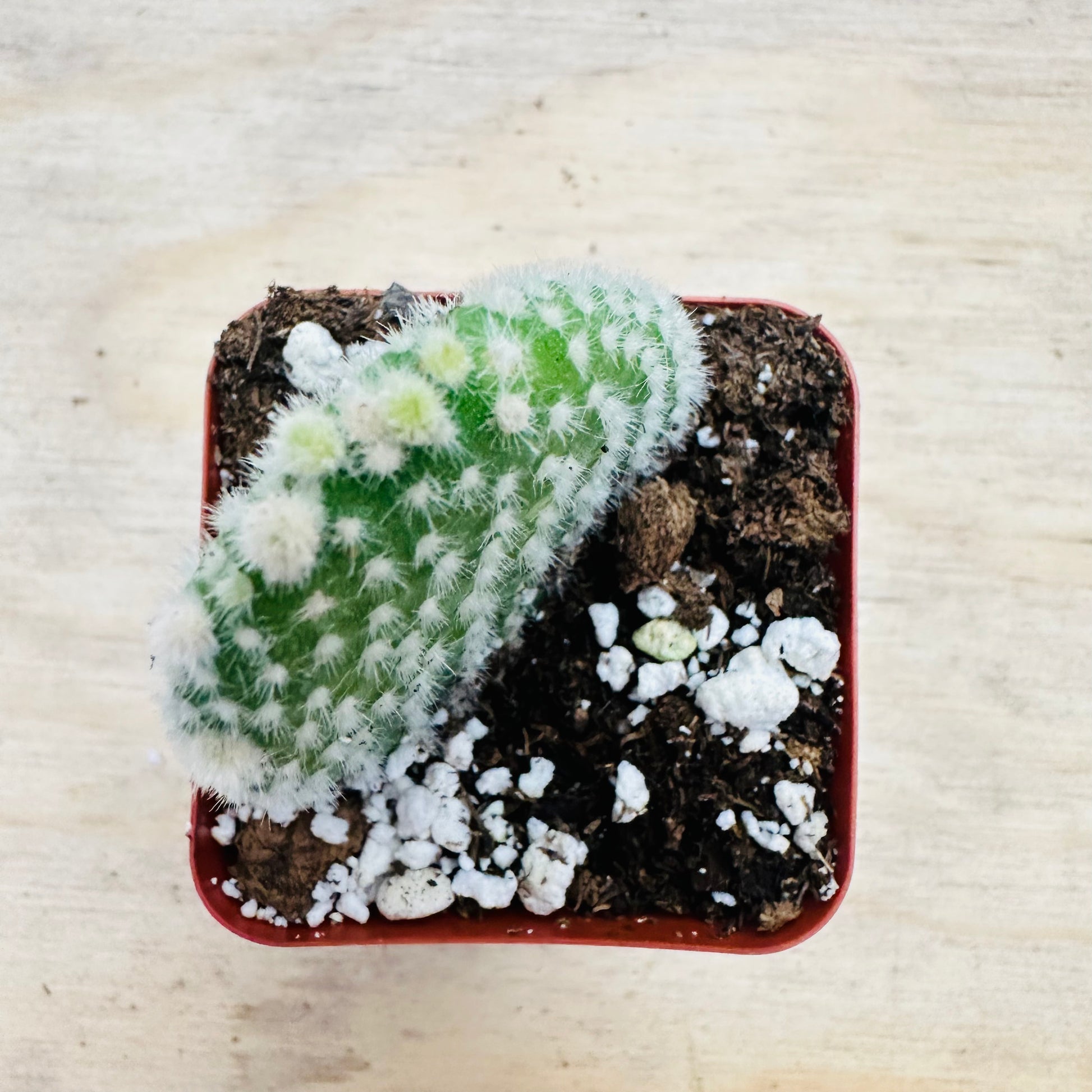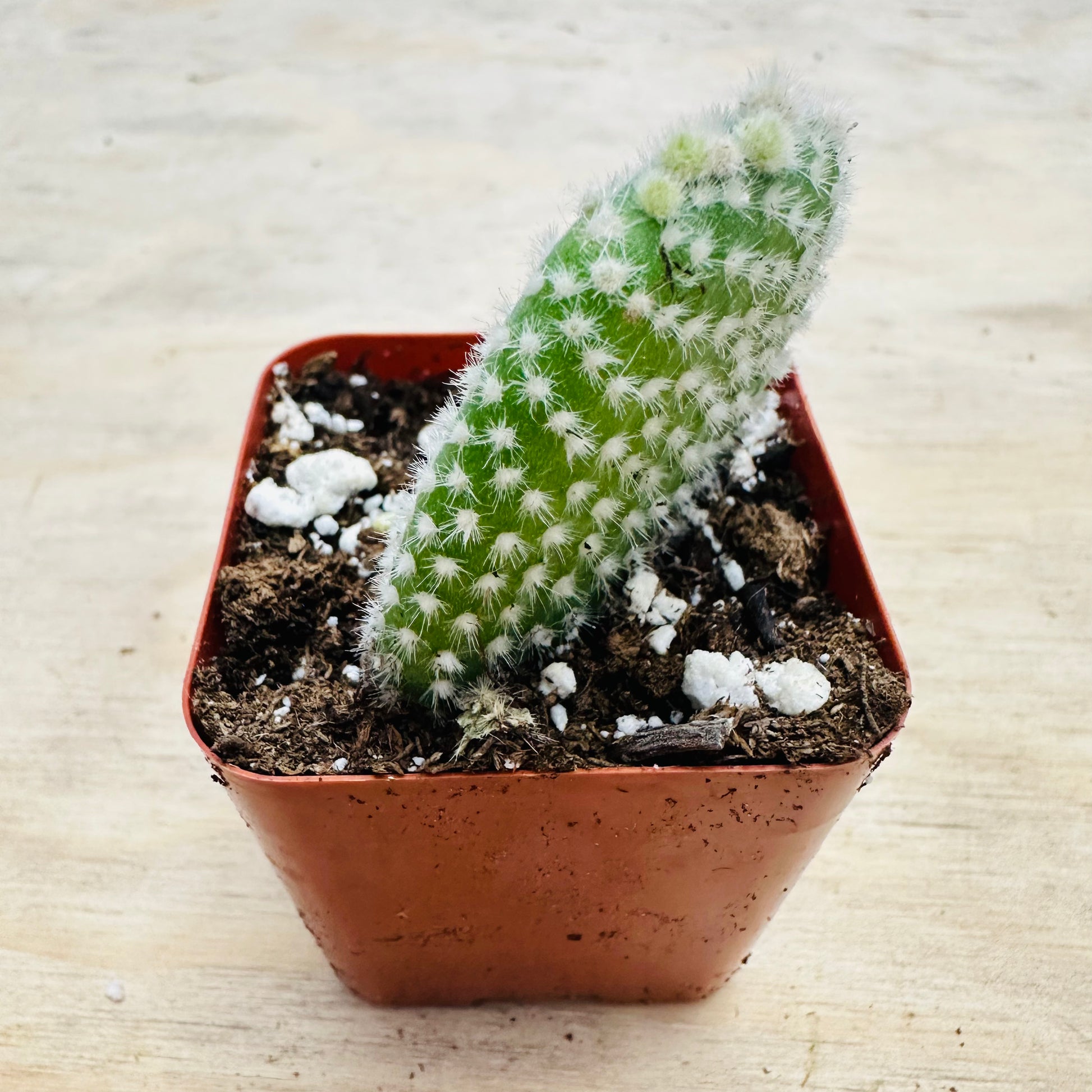Opuntia microdasys var. albospina - White Bunny Ears
Opuntia microdasys var. albospina - White Bunny Ears
In stock
Couldn't load pickup availability
📝 Description
**Morphological Characteristics**
Opuntia microdasys var. albospina, commonly known as "White Bunny Ears," is a charming variant of the Opuntia microdasys species, belonging to the Cactaceae family. Native to northern and central Mexico, this cactus is renowned for its distinctive appearance, featuring flat, oval-shaped pads that grow in pairs, resembling the ears of a rabbit.
The pads are a bright green color and are densely covered with small, evenly spaced clusters of white glochids (tiny, hair-like spines). These glochids give the plant a soft, fuzzy look, though they can detach easily and irritate the skin upon contact. Each pad can grow up to 10-15 cm (4-6 inches) long and 7-10 cm (3-4 inches) wide. White Bunny Ears may occasionally produce small, yellow, cup-shaped flowers in the summer, followed by reddish-purple fruits under ideal conditions.
**Growth Habits**
White Bunny Ears is a moderately fast-growing cactus that forms a bushy, multi-stemmed clump over time. It tends to grow upright initially but may sprawl slightly as the plant matures. It typically reaches a height and width of 30-60 cm (12-24 inches) when grown under favorable conditions. It is an excellent choice for container gardening, xeriscaping, and decorative displays, thriving both indoors and outdoors in warm climates.
**Maintenance Points**
• Lighting: Prefers full sun to bright, indirect light. Outdoors, it should be placed in a sunny location with some protection from harsh afternoon sun in extremely hot climates. Indoors, a south- or west-facing window is ideal.
• Watering: Water thoroughly but infrequently. Allow the soil to dry out completely between waterings. Reduce watering during the winter months when the plant enters dormancy. Overwatering can easily lead to root rot.
• Soil: Use a fast-draining cactus or succulent mix. Adding coarse sand, perlite, or pumice to the soil improves drainage and reduces the risk of root issues.
• Temperature: Ideal temperatures are between 18-30°C (65-86°F). It is sensitive to frost and should be protected from temperatures below 0°C (32°F). In cooler regions, it should be grown in containers and brought indoors during the winter.
• Fertilization: Fertilize once a month during the growing season (spring and summer) with a diluted, balanced cactus fertilizer. Do not fertilize during the dormant winter period.
• Potting: Ensure pots have adequate drainage holes. Repot every 2-3 years or when the plant becomes root-bound, ideally in the spring.
• Humidity: Prefers low humidity environments. Good air circulation is beneficial for preventing fungal problems.
**Reproduction Method**
White Bunny Ears can be easily propagated through pad cuttings and, less commonly, by seeds.
1. **Pad Cuttings:**
• Selection: Gently twist or cut off a healthy pad using gloves or tongs to avoid glochid contact.
• Callusing: Allow the pad to dry and callus for several days in a shaded, dry area to prevent rot when planted.
• Planting: Insert the callused end into a well-draining cactus mix, just deep enough to stand upright.
• Aftercare: Place in a warm, bright location with indirect sunlight and water lightly after a few days. Roots typically develop within 2-4 weeks.
2. **Seeds:**
• Sowing: Sow seeds on the surface of a sterile, well-draining mix. Lightly cover with a thin layer of sand or fine soil.
• Germination: Maintain slightly moist conditions and keep temperatures between 21-27°C (70-80°F). Germination may take several weeks.
• Transplanting: Once seedlings are large enough to handle, transplant them into individual pots.
**Additional Tips**
• Pest Control: Monitor for common pests such as mealybugs, spider mites, and scale. Treat infestations promptly with insecticidal soap or neem oil.
• Disease Prevention: Ensure excellent drainage and avoid overwatering. Remove any damaged or rotting pads promptly.
• Handling: Always use gloves or tools when handling to avoid contact with glochids.
• Flowering Encouragement: Providing bright light and a proper winter dormancy period (cooler temperatures, minimal watering) can encourage flowering in the summer.
With its adorable appearance and relatively easy care, Opuntia microdasys var. albospina 'White Bunny Ears' is a delightful addition to any cactus or succulent collection, bringing a whimsical and sculptural element to gardens and indoor spaces alike.
🌿 Care Tips
Plant Care
Light
Water
Soil
Temperature
🌟 Note: It’s normal for succulents to appear slightly shriveled after shipping. They usually recover within a few days in a suitable environment.
📦 Shipping Info
Seah Shipping Policy
Effective Date: November 2025
This Shipping Policy applies to orders delivered within the continental United States (the lower 48 states). By purchasing from Seah, you agree to the terms below.
1) Shipping Cost & Free Shipping
- Automatic rate calculation: Shipping is calculated at checkout based on weight, destination ZIP and carrier rates.
- Free Standard Shipping: Orders $59+ (pre-tax, after discounts) ship free to the lower 48 states.
- Alaska, Hawaii, Puerto Rico & other territories: Not eligible for free shipping or standard flat offers at this time.
- Taxes/Duties: Applicable sales tax and any fees are shown at checkout.
2) Processing Schedule
- Business days only: We process and ship Monday–Friday. No shipping on weekends or U.S. federal holidays.
- Handling time: 1–3 business days after payment confirmation.
- Cut-off time: Orders placed before 3:00 PM (PST) are prioritized for same-day processing; others roll to the next business day.
- Changes/Cancellations: Email support@seah.co within 12 hours of purchase; after that, the order may already be in processing.
3) Transit Times
| Method | Estimated Transit | Total ETA (Handling + Transit) |
|---|---|---|
| Standard | 5–8 business days | 6–11 business days |
| Express | 3–4 business days | 4–7 business days |
ETAs are estimates. Weather, holidays, carrier delays or high-volume periods may extend delivery times.
4) Seasonal Temperature & Plant Safety
- Winter (Nov–Mar): We strongly recommend adding a heat pack at checkout to protect plants from freezing. Orders shipped without a heat pack during cold conditions are not covered for cold damage.
- Summer heat: During extreme heat waves, we may hold shipments until temperatures normalize. We’ll notify you if there’s a hold.
- Packaging: Plants are carefully packed (bare-root or potted by type/size) to minimize transit stress.
5) Carriers & Tracking
- We ship via USPS / UPS / FedEx, selected automatically for best service to your address.
- When your order ships, you’ll receive a tracking email. Tracking typically activates within 24 hours.
- If you haven’t received tracking within 3 business days, contact us at support@seah.co or +1 (626)-999-1314.
6) Address Changes & Delivery Issues
- Before shipment: Request address changes within 12 hours of ordering.
- After shipment: We can’t modify the address once dispatched. Please contact the carrier for redirection options.
- PO Boxes: Supported for USPS only; UPS/FedEx require a street address.
- Seah isn’t responsible for delays or loss due to incorrect addresses provided at checkout.
7) Service Area
We currently ship to the continental U.S. (lower 48 states). Orders to AK/HI/PR and other territories are not eligible for free shipping and may be restricted.
8) Support
- Hours: Mon–Fri, 9:00 AM – 5:00 PM (PST)
- Phone: +1 (626)-999-1314
- Email: support@seah.co
- Address: 7870 Margaux Pl, Rancho Cucamonga, CA 91739, United States
Thank you for supporting our California nursery—each plant is hand-selected and packed with care. 🌱






